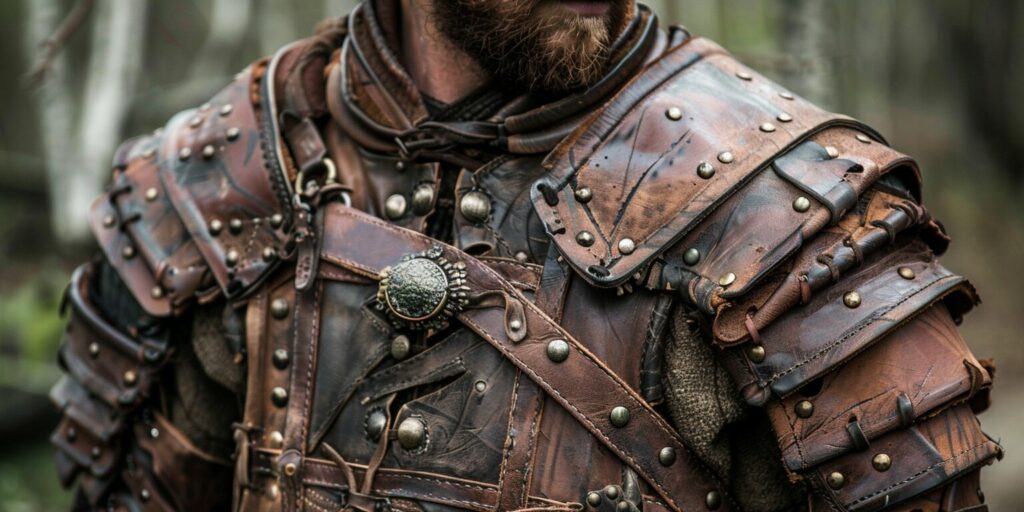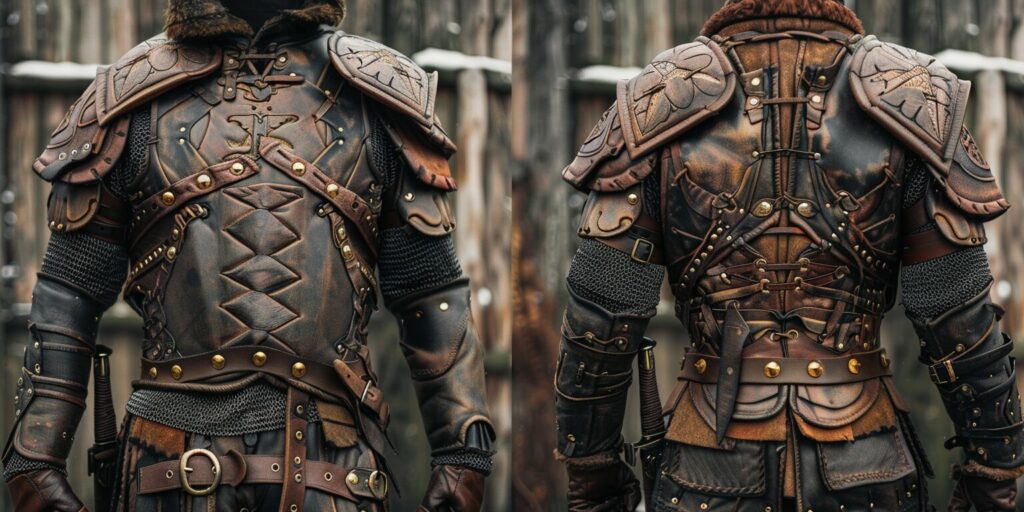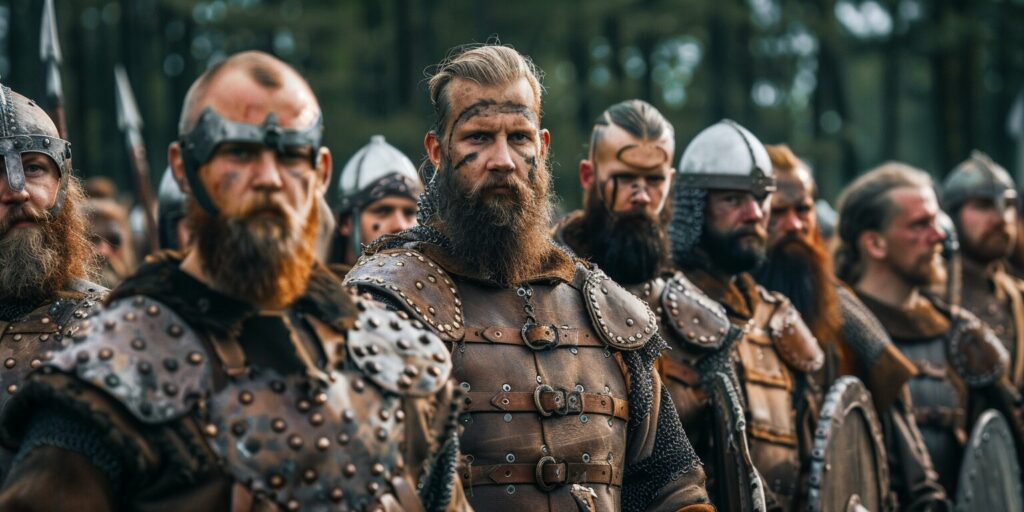Viking Weapons and Armor, Vikings
Exploring Viking Leather Armor and Its Role in Norse Warfare
The Viking Age lasted from 793 to 1066 AD. It was a time known for its raids, exploration, and tough battles. Viking armor, especially the leather kind, was key to their survival. This type of armor was praised for being easy to get, flexible, and simple to make. It protected Viking fighters well in their many wars.
“The Vikings: A History” by Robert Ferguson explains that Viking leather armor was essential for protection and for showing who they were. It was not just about staying safe. Wearing leather armor also showed a Viking’s role and dedication in their society. “Medieval Scandinavia: An Encyclopedia” notes that making this armor showed off the Vikings’ talent and cleverness. They could fashion leather vests, belts, and greaves with great skill.
In “The Real Vikings: Craftsmen, Traders, and Fearsome Raiders,” Melvin Berger highlights the use of leather armor. Its lightweight strength allowed the Vikings to move quickly in battles, making it easier for them to win. Leather armor was a big part of Viking success stories, and the book shows just how important this kind of armor was for their fights and travels.
What Is The Significance Of Viking Leather Armor In Norse History?
Leather Viking armor was key in Norse history for its usefulness and flexibility in battle. It lets fighters move quickly and stay safe. Over time, this armor became a critical part of Viking defense.
Evolution Of Viking Armor Materials
Viking armor changed from just hides to layered leather plates. This new design provided more protection and movement and showed the Vikings’ growing skill in making armor.
Role Of Leather Armor In Viking Warfare
Leather armor was a must in Viking wars for its mix of safety and freedom. It was light yet strong, perfect for their attack style. This made it the go-to body armor for Norse fighters.
Comparison Of Leather Armor With Other Materials Used By Vikings
Leather was cheaper and easier to obtain than metal armor, which was heavier and more expensive. Although metal armor was safer, leather gave the Vikings a good compromise. Leather body armor allowed for more warrior agility but protected less against sharp weapons.
- Accessibility: Leather was more readily available compared to metals, making it widely used among Viking warriors.
- Cost: Leather armor was cheaper to produce, allowing more warriors to equip themselves adequately for battle.
- Protection: Although offering less protection than metal, leather armor still provided sufficient defense while maintaining warrior agility.
Changing armor greatly influenced Viking battles. Leather designs, like lamellar armor, greatly impacted their success. Thus, the journey of Viking body armor, especially brown leather, was an essential part of their legacy.
How Was Historical Viking Leather Armor Crafted?
Learning about Viking leather chest armor shows how art and function came together. Early Norse fighters used special methods to create armor that was not only protective but also allowed freedom of movement. They started by softening animal hides and carried on to add detailed designs to the body armor. Each step played a key role in creating armor that worked well for the warriors.

Techniques For Making Leather Armor
To make leather Viking armor, craftsmen first picked the best hides. They then treated the leather to make it strong and resistant to cold. Careful cutting and sewing turned the leather into the armor pieces needed, like chest protectors. This ensured the armor was tough and would last long.
Embossing And Decorative Elements On Leather Armor
Viking makers loved to decorate the leather body armor they made. They used special methods to add designs, often showing cultural symbols or beautiful patterns. Not only did these body armor designs look good, but they also provided extra protection. The decorated armor showed how skilled and important the wearer was.
Types Of Leather Armor Pieces Worn By Viking Warriors
Vikings wore many kinds of leather armor depending on their activities. They had simple tunics for everyday needs, stronger vests for better protection, and chest armor for fighting. They also used bracers and greaves to shield their arms and legs without losing flexibility. Each piece of armor was made to keep the warrior safe and swift in battle.
What Were The Different Types Of Viking Leather Armor Available?
Viking warriors wore different kinds of leather body armor based on their jobs and status. These armors were important for protection and showed their culture.
Exploring Leather Bracers And Arm Protection
Bracers protected Viking warriors’ arms, especially those who used bows or swords. They were sturdy and coolly designed. Some body armor was metal for extra safety but still let warriors move easily.
Significance Of Leather Vests In Viking Attire
Leather vests were a key part of Viking armor, safeguarding the chest. They kept warriors flexible and ready. Vests could also have metal for better protection but remained comfortable during fights and long journeys.
Role Of Leather Belts And Greaves In Viking Armor Sets
Leather belts did more than just hold clothing; they often featured a buckle for added style. They carried weapons and important things. Belts were strong and might have had metal to help out. Viking greaves protected the lower legs in battles. They used tough leather and metal to keep warriors safe.
Historical Viking leather armor was crucial in their battles. It ranged from bracers for arm safety to belts for carrying tools. Those interested should look into books like “Age of the Vikings” by Anders Winroth, “The Vikings and Their Enemies” by Philip Line, and “The Sea Wolves: A History of the Vikings” by Lars Brownworth for more.
How Is Viking Leather Armor Utilized In Modern Contexts?
Today, many people use Viking leather chest armor in games and events like LARP and cosplay. It mixes old Norse history with fun fantasy elements, making these activities more exciting for everyone.

Adaptation Of Viking Leather Armor For LARP And Cosplay
LARP and cosplay groups love using Viking armor. They create it using special crafting skills. This makes the armor look good and tough to use at events.
Their attention to detail is amazing. They use real materials and ancient crafting methods. This helps them feel like true Viking characters, creating a very immersive experience.
Integration Of Historical Accuracy In Modern Leather Viking Costumes
Many fans focus on making Viking armor as true to history as possible. They study Norse designs and techniques carefully. They read books like “Fashion in the Age of the Vikings” to get it right.
This effort shines in the quality of the armor made today. It reflects the real items Vikings used. So, fans of these costumes can feel a strong connection to Viking traditions.
Popularity Of Fantasy Viking Leather Armor Among Enthusiasts
Armors with a twist, mixing Viking and fantasy themes, are very popular. Shows like “Vikings” and games are big influences. They add unique elements to traditional armor, attracting many fans.
These unique designs spark creativity. Cosplay artists and fans enjoy creating their own versions. They aim to capture the legendary and mysterious spirit of Viking warriors, and thus, fantasy Viking armor is in high demand.
Bottom Line
Viking leather armor patterns show the Vikings’ deep connection to their culture. Viking leather body armor was more than just for fighting. It was about showing their pride and strength. The details in leather body armor and bracers show how much they cared about their history and art.
Today, people still love Viking armor for games and dressing up. They try hard to make the leather armor look real. This keeps the spirit of the Vikings going. It shows a link between now and back then. People who love this culture help it stay alive by making new things inspired by the Vikings.
People are still excited about Viking armor because it shows the way the Northmen lived. It’s seen in shows, books, and more. Combining history with creativity makes Viking armor memorable for us. It makes us feel like we’re part of that interesting medieval armor time in the past.

